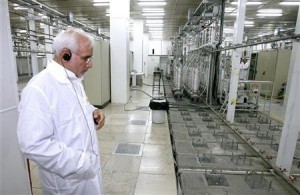By Khaleej Times
Iran is set to be in focus at a UN atomic agency board meeting starting Thursday, not only because of ongoing suspicions of a covert weapons drive but also over safety concerns over its only operating nuclear power plant.
The International Atomic Energy Agency’s latest report on Iran on November 16 showed that despite sanctions pressure, Iran has continued to expand its capacity to enrich uranium to purities of 20 percent, close to the 90 percent mark needed for a weapon.
Iran says that this process is to produce nuclear medicines but Western countries and independent experts say that it is producing far more enriched uranium than can be justified by Teheran’s civilian programme in its current form.
In particular, the IAEA said that Iran had finished installing centrifuges — machines that enrich uranium gas by spinning it at supersonic speeds — at Fordo, a facility dug into a mountain that Iran only told the IAEA about in 2009.
Once Fordo is fully up and running, Iran will be able to produce 45 kilos (99 pounds) of 20-percent uranium per month, up from 15 kilos at present, or enough for a nuclear weapon’s worth — although it would have to be further enriched — every five and a half months.
This adds to pressure on the US, China, Russia, Britain, France and Germany to renew efforts to seek a diplomatic solution, with a meeting with Iran expected in early 2013 or possibly sooner, the first since June.
Parallel talks between the IAEA and Iran are set to resume on December 13 in Teheran, meanwhile, focused on what the agency calls ‘overall, credible’ evidence that until 2003, and possibly since, Iran conducted nuclear weapons research.
Israel, the Middle East’s sole if undeclared nuclear-armed state, has refused to rule out resorting to military action if diplomacy fails.
Reactor problems
As well as highlighting Iran’s continued expansion, the IAEA’s report this month also said that fuel has been unloaded at Iran’s Bushehr reactor, shutting it down.
Iran’s envoy to the IAEA, Ali Asghar Soltanieh, told AFP that the move was a ‘normal technical procedure’ but Western diplomats said it raised fresh questions about safety at the 1,000-megawatt plant.
‘This is not a routine matter or something that is ordinary. This is a matter of great concern,’ one senior Western official said.
The facility on the Gulf coast, started by Germany’s Siemens before the 1979 Islamic revolution and completed by Russian firm Rosatom, was only plugged into the nation grid in late 2011 after years of financial, technical and political delays.
Although spent fuel from Bushehr could in theory be used to produce plutonium for a nuclear weapon, Western countries do not see a risk that the plant could be used for this purpose.
‘Light-water’ reactors like Bushehr do not produce plutonium of a quality appropriate for a bomb, and any move to adjust it to do so would quickly be detected by the IAEA, which conducts regular inspections there.
Of more concern is the ‘heavy-water’ reactor at Arak that Iran has told the IAEA it intends to begin operating in the first quarter of 2014. Such a reactor would be far more suitable for producing weapons-grade plutonium.
But Bushehr’s latest setback — not the first — is another example of Iran shooting itself in the foot by its ‘opacity,’ said Mark Fitpatrick from the International Institute for Strategic Studies think-tank in London.
This newest suspected problem at Bushehr ‘is probably not something to be overly worried about, either on proliferation or safety grounds,’ Fitpatrick told AFP. ‘It is probably some glitch and Iran is taking proper precautions.’
‘But because of the way Iran does this, without giving any details, it naturally creates concerns,’ he said.
Iran is the only country with an operating nuclear reactor that does not adhere to the Convention on Nuclear Safety, drawn up after the 1986 Chernobyl disaster in order to improve transparency and safety, he said.
The Iran Project is not responsible for the content of quoted articles.

 QR code
QR code